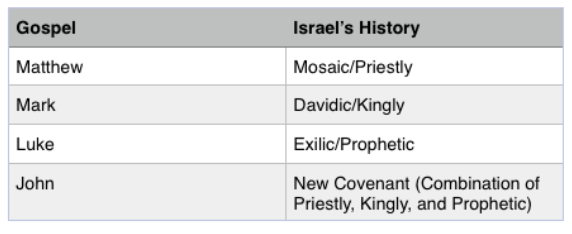What are we to make of the dissimilarities between the four Gospels? The (cynical) critical scholars will tell us that all differences are dissonance.
But there are differences. How should we process the obvious distinctions? I suggest taking a few piano lessons.
But there are differences. How should we process the obvious distinctions? I suggest taking a few piano lessons.
The composition of the gospels reveals a 𝑚𝑢𝑠𝑖𝑐𝑎𝑙 methodology. The various parts of a concerto are symmetrical but not identical. This purposeful diversity establishes the unity of the piece. This is what we call ℎ𝑎𝑟𝑚𝑜𝑛𝑦.
Played on time and in tune, the varied bits form a symphony rather than a cacophony. It is fitting then that the One who gave the morning stars their song and taught the birds to sing it would commission a quartet to deliver to us the good news of the kingdom.
"Since there are four zones of the world in which we live, and four principal winds, while the Church is scattered throughout all the world...it is fitting that she should have four pillars, breathing out immortality on every side, and vivifying men afresh.
"From which fact, it is evident that the Word, the artificer of all, he that sitteth upon the cherubim, and contains all things, He who was manifested to men, had given the gospel under four aspects, but bound together by one Spirit…
"For the cherubim too were fourfaced, and their faces were images of the dispensation of the Son of God. For, as the Scripture says, ‘The first living creature was like a lion,’ symbolizing His effectual working, His leadership, and royal power;
"the second was like a calf, signifying His sacrificial and sacerdotal order; but the third had, as it were, the face of a man—an evident description of His advent as a human being;
"the fourth was like a flying eagle, pointing out the gift of the Spirit hovering with His wings over the Church: Matthew shows him as a man, Mark as a lion, Luke as a calf, John is the eagle." ~Irenaeus, 𝐴𝑔𝑎𝑖𝑛𝑠𝑡 𝐻𝑒𝑟𝑒𝑠𝑖𝑒𝑠
Irenaeus would go on to argue that the four gospels pictured the history of the Elder Testament, each of the accounts corresponding to what he saw as the principal covenants of redemptive history: the antediluvian, the Noahic, the Mosaic, and the New Covenant.
Just so, the gospels function in a recapitulatory fashion, retelling and recasting the history of Israel in and through the person of Messiah.
Matthew is a Mosaic mosaic. Law looms large over his narrative. This is seen clearly in the Sermon on the Mount (Mt. 5-7), the various teachings concerning discipleship (Mt. 10, 18), and in a host of references to the Hebrew Scriptures which portray Jesus as a new Moses.
Mark gives us the “busy Christ,” always on the move, always acting “now” or “immediately.” Always razing hell. He is the stronger Strong man who faces down demons. He is also presented as great David’s Greater Son—the true Davidic king.
Luke is interested in those with whom no one else is interested; the poor, the outcasts, the neglected. He dates the scenes in his drama by referencing Roman rulers so that the story is contextualized within Roman history—Israel in the midst of the Gentiles; a post-exilic exile.
John does something completely different. While he references the Old Testament (a lot), he does so in a unique way. Whereas the other evangelists evoked images of OT personalities in order to demonstrate similarities, John mentions them to manifest the striking dissimilarities.
Moses may have delivered the word of the Lord but Jesus is that Word. The law may have come by Moses but grace and truth comes in Jesus the Christ. John opens his gospel in such a way that he wants us to understand that, in Jesus, the world is made new—a new Genesis.
Thus, Jesus is both the climax of Israel’s history and the commencement of the history of a brand new creation.

 Read on Twitter
Read on Twitter


